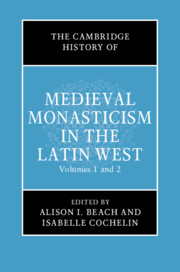Book contents
- The Cambridge History of Medieval Monasticism in the Latin WEST
- The New Cambridge History of Medieval Monasticism in the Latin West
- The Cambridge History of Medieval Monasticism in the Latin WEST
- Copyright page
- Contents
- Figures
- Contributors
- Acknowledgments
- Abbreviations
- 1 General Introduction
- Part I The Origins of Christian Monasticism to the Eighth Century
- Part II The Carolingians to the Eleventh Century
- Part III The Long Twelfth Century
- 34 Historiographical Approaches to Monasticism in the Long Twelfth Century
- 35 Sources for Monasticism in the Long Twelfth Century
- 36 Hermitism in the Eleventh and Twelfth Centuries
- 37 Monastic Theologies, c. 1050–1200
- 38 Monastic Preaching and the Sermon in Medieval Latin Christendom to the Twelfth Century
- 39 The Mass in Monastic Practice: Nuns and Ordained Monks, c. 400–1200
- 40 Reclusion in the Middle Ages
- 41 Similarities and Differences between Monks and Regular Canons in the Twelfth Century
- 42 The Institutionalization of Religious Orders (Twelfth and Thirteenth Centuries)
- 43 Gender and Monastic Liturgy in the Latin West (High and Late Middle Ages)
- 44 Monastic Landscapes
- 45 Later Monastic Economies
- 46 Nobility and Monastic Patronage: The View from Outside the Monastery
- 47 The Medical Role of Monasteries in the Latin West, c. 1050–1300
- 48 East-Central European Monasticism: Between East and West?
- 49 Monasticism, Colonization, and Ethnic Tension in Late Medieval Ireland
- Part IV Forms of Monasticism in the Late Middle Ages
- Index
- References
46 - Nobility and Monastic Patronage: The View from Outside the Monastery
from Part III - The Long Twelfth Century
Published online by Cambridge University Press: 16 January 2020
- The Cambridge History of Medieval Monasticism in the Latin WEST
- The New Cambridge History of Medieval Monasticism in the Latin West
- The Cambridge History of Medieval Monasticism in the Latin WEST
- Copyright page
- Contents
- Figures
- Contributors
- Acknowledgments
- Abbreviations
- 1 General Introduction
- Part I The Origins of Christian Monasticism to the Eighth Century
- Part II The Carolingians to the Eleventh Century
- Part III The Long Twelfth Century
- 34 Historiographical Approaches to Monasticism in the Long Twelfth Century
- 35 Sources for Monasticism in the Long Twelfth Century
- 36 Hermitism in the Eleventh and Twelfth Centuries
- 37 Monastic Theologies, c. 1050–1200
- 38 Monastic Preaching and the Sermon in Medieval Latin Christendom to the Twelfth Century
- 39 The Mass in Monastic Practice: Nuns and Ordained Monks, c. 400–1200
- 40 Reclusion in the Middle Ages
- 41 Similarities and Differences between Monks and Regular Canons in the Twelfth Century
- 42 The Institutionalization of Religious Orders (Twelfth and Thirteenth Centuries)
- 43 Gender and Monastic Liturgy in the Latin West (High and Late Middle Ages)
- 44 Monastic Landscapes
- 45 Later Monastic Economies
- 46 Nobility and Monastic Patronage: The View from Outside the Monastery
- 47 The Medical Role of Monasteries in the Latin West, c. 1050–1300
- 48 East-Central European Monasticism: Between East and West?
- 49 Monasticism, Colonization, and Ethnic Tension in Late Medieval Ireland
- Part IV Forms of Monasticism in the Late Middle Ages
- Index
- References
Summary
Secular noblemen and noblewomen’s relationships with monastic communities during the high Middle Ages follow many of the patterns already established in the preceding centuries. Across Latin Christendom, nobles continued to make donations to religious houses for the sake of their own souls and those of their ancestors and other relatives. Similarly, those who had sufficient resources to found new monasteries continued to do so, establishing and endowing religious communities dedicated in perpetuity to their spiritual well-being and the preservation of their memories. As in earlier centuries, nobles’ motives for patronizing monastic houses were not confined solely to the religious sphere. Anthropological models of “gift-giving” (as discussed by Isabelle Rosé in her article in volume 1) can be applied to the property agreements between nobles and monasteries of the high Middle Ages as well. Conflicts over lands and rights also continued to unsettle local societies, because the shifting nature of patronage and kinship networks over time repeatedly opened new questions about which nobles had claims to a piece of property even after it had been donated to a religious community.
- Type
- Chapter
- Information
- The Cambridge History of Medieval Monasticism in the Latin West , pp. 848 - 864Publisher: Cambridge University PressPrint publication year: 2020

